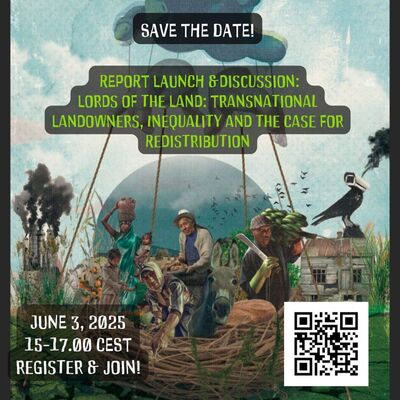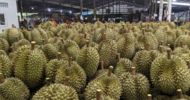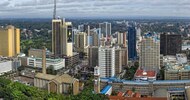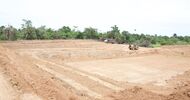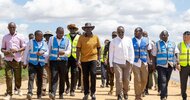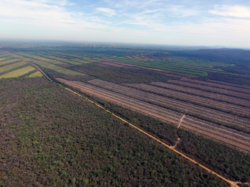
Mongabay | 3 April 2023
Expansion of Mennonite farmland in Bolivia encroaches on Indigenous land
by Iván Paredes Tamayo | Translated by Matthew Rose
Mennonites first began settling in Bolivia in the 1950s, primarily in the department of Santa Cruz.
Today, Bolivia’s Mennonite population numbers around 150,000, most of whom are involved in mechanized, industrial agriculture.
Life goes at its own pace in the town of Chihuahua, where the modern mixes with Mennonite traditions. To one side, horse-drawn carts pull up at a plot of land that stands in the middle of the plain. To the other, an almost-new car parks in front of a chalet-style house. Such is life on this Mennonite colony located in the eastern Bolivian municipality of Cuatro Cañadas.
The colony’s 280 families are considered rebels by other Mennonites, having drifted from the denomination’s strict way of life, which forbids the use of many forms of modern technology. The town’s streets are lined with heavy machinery; residents, many of whom have forgone the traditional Mennonite dress, walk around with mobile phones in their hands.
However, like those of other Mennonite communities in Latin America, Chihuahua’s Mennonite families are masters of agribusiness and soy cultivation — and are continually expanding their industrial farms.
Mennonites first began settling in Bolivia in the 1950s, primarily in the department of Santa Cruz. This region of Bolivia holds more than two-thirds of country’s cultivated land and is characterized by large-scale industrial agriculture of commodity crops destined for international markets. Today, Bolivia’s Mennonite population numbers around 150,000.
The Mennonite colony of Chihuahua was founded in 1989 and lies 132 kilometers (82 miles) from the nearest large city of Santa Cruz de la Sierra. Access to the colony is strictly controlled; each entry point to Chihuahua is manned by security guards and equipped with CCTV cameras and communication systems.
The colony’s soy fields stretch for miles beyond the town. Indigenous residents say they now extend into contested land near the Indigenous community of San Miguelito, and that the Mennonite community is responsible for it. Community members say cattle ranchers are also trying to expand their ranches into the territory.
Some local residents told Mongabay Latam they have already been persuaded to sell their property to agribusiness and Mennonite entrepreneurs. Others say they have held out; of those, many add they see it as nearly inevitable that they will one day be forced to sell.
“They are drawing near from the Chihuahua colony. It’s the Mennonites who are the ones who grow soybeans and other crops, but there are also cattle ranchers, said Marco Vera, who lives in Lomerío Indigenous Territory and has land in San Miguelito. “People are divided here, but many have already given in and sold their land. I don’t know how much they are paid, but there are a few of us who are resisting.”
Representatives of the Chihuahua Mennonite colony refused to answer Mongabay’s questions.
Large scale deforestation in the area is encroaching on two of the region’s formally recognized Indigenous territories: Zapocó and Lomerío. Satellite data and imagery from monitoring platform Global Forest (GFW) Watch show agricultural expansion and associated road development gobbling up forest along the borders of the territories as recently as January. For Lomerío, clearing appears to have spread into the territory itself in 2022, according to GFW data.
María Choré is the president of the Autonomous Consultative Council of the Indigenous Territory of the Monkoxi de Lomerío Nation. She said agribusiness is dividing and destroying several communities and affecting their territory, and she called for authorities to take swift action to stop the clearing of protected forest for agriculture and other industries.
“Our territory, the first to declare itself as Indigenous in Bolivia, is in danger because we are going through problems with mining, invaders and agribusiness,” Choré said.
Gonzalo Colque is a researcher for Fundación Tierra, an organization that focuses on sustainable rural development and assistance to Indigenous and small-scale farming populations of Bolivia. He told Mongabay there are currently more than 100 Mennonite colonies in Bolivia, almost all of which are dedicated to soybean production. Colque added that some of these colonies have been transformed into agribusinesses and have bought tracts of property on public land.
“Mennonite communities and deforestation can be found in every place along the agricultural frontier, which is expanding, and in most cases in those areas it is mostly soybean production [that predominates],” Colque said. “[If] we go to San José de Chiquitos, there are Mennonites; [if] we go to the [Bolivian] Chaco, there are also Mennonites. For example, the amount of land being used by the Mennonites around Laguna Concepción is enormous, [and] they have moved into the protected area.”
Laguna Concepción Municipal Protected Area lies some 100 kilometers (62 miles) southwest of San Miguelito, and about 60 kilometers (37 miles) south of Lomerío and Zapocó indigenous territories. It was established in 2002 to protect Concepción Lake and its surrounding habitat. The site is also listed as a wetland of international importance under the Ramsar Convention.
But Concepción Lake is no longer there. Satellite imagery from Planet Labs visualized on Global Forest Watch shows the its water levels starting dropping quickly in 2020; by December, only a small pool remained in the middle of the lakebed. By April 2022 it had entirely disappeared.
Colque and other regional land use experts say the disappearance of Concepción Lake was caused by the expansion of Mennonite agriculture. According to research conducted by Fundación Tierra, Mennonite colonies constructed canals that drained the lake to irrigate their crops. Fundación Tierra found that the canals also transported pollutants from fields to what remained of the lake and its surrounding ecosystem.
Colque said Fundación Tierra was also aware of instances in which Mennonite groups have purported to be traditional, small-scale farmers in order to obtain rights to land that would normally be denied to large-scale agricultural operations.
The growing presence of Mennonite communities in Bolivia has divided the country. On one side are business owners, local governments and communities that say Mennonite exports are a boon to Bolivia’s economy. On the other are small-scale farming unions, Indigenous alliances and environmental organizations that accuse Mennonite communities of encroaching on land that belongs to Indigenous and small farmers, as well as deforesting and damaging vast areas of habitat.
“In relation to land access and tenure, with full knowledge of the facts, I must affirm that the majority of the high religious hierarchy of the Mennonite colonies, their ministers, are an important part of the land trafficking chain in eastern Bolivia,” said Eulogio Núñez during a 2020 press conference when he was director of the Center for Investigation and Promotion of Campesinos (CIPCA), an advocacy organization that focuses on traditional and small-scale farmers in Bolivia. In 2020, Núñez also claimed that a large portion of the property owned by the Mennonites was illegally acquired.
Today, Núñez is national director of the National Institute of Agrarian Reform (INRA) and now chooses his words more carefully when referring to Bolivia’s Mennonite communities. However, he is still concerned about the expansion of their agricultural holdings, referring to them as “invaders” when describing the Valle Verde colony, located in the community of Quimome in the municipality of San José de Chiquitos.
“They tried to extend beyond what is legal and that is not allowed,” Núñez said during a public event in 2022. “In fact, where they wanted to extend into is public land.” He added that, “we are not going to allow the encroachment of public lands […] rather they have to return to their old colony; they extended more than they were allowed.”


